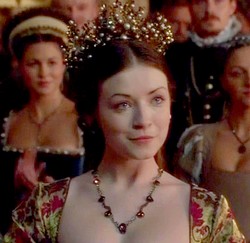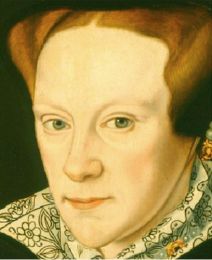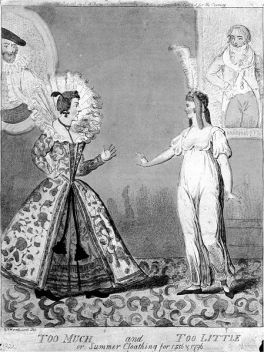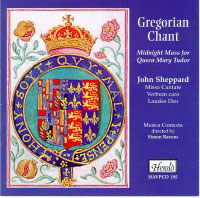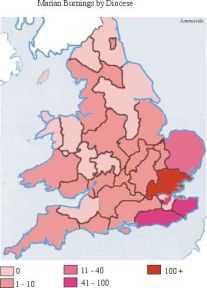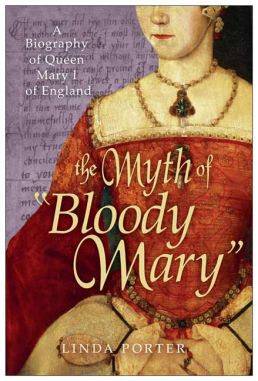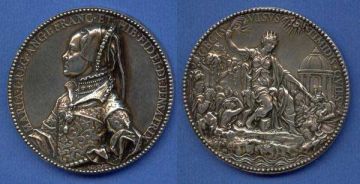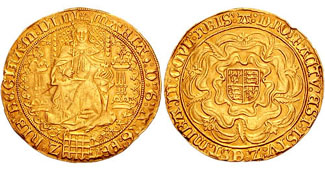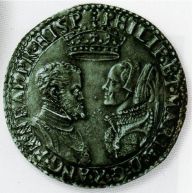Queen Mary I - Historical profile - Page 2
Jump to navigation
Jump to search
| Mary's economic policy: Mary's government had good relations with England's merchants and were able to increase both the level of custom duties and the number of commodities on which duty was assessed. The new Book of Rates was introduced in 1558 - a boon for Elizabeth, but too late to benefit Mary. Elizabeth was also the beneficiary of Mary's continued efforts to restore the currency to purity. Mary issued fine silver coins and devised a plan to withdraw debased coins that came to fruition in 1560-61. 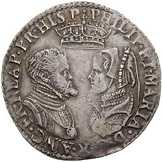 The years 1555 and 1556 saw very bad weather (floods in Fall 1555 were followed by a drought in the Spring of 1556). This caused extremely poor harvests. The debilitated population was also hit by an epidemic of influenza that killed about twenty percent of the population. The bad economic conditions did not spark peasant unrest. The one serious revolt of Mary's reign stemmed from religious and political discontent. "Too much and Too little," a satirical contrast between Marian clothes of 1556 and the cutting-edge clothes of 1796. Note: Although the year the drawing was comparing (1556) clothes from the time of Mary, the clothing is definitely Elizabethan. | Mary's Foreign policy: Richard Chancellor and Sir Hugh Willoughby tried, without success, to discover a north-eastern route by sea to Asia. Willoughby, however, died of exposure in Lapland, but Chancellor reached the White Sea and traveled by land to Muscovy where he established links with Ivan IV. In 1555, a Charter was issued to the Muscovy Company giving it exclusive trading rights in the region. Further expeditions were made in 1556, 1568 and 1580. Richard had been in service to King Edward VI, Mary's brother, but when Chancellor returned to England in the summer of 1554, King Edward was dead. Mary was now Queen and no stigma was attached to Chancellor and the Muscovy Company, as the association was now called. Mary sent Chancellor again to the White Sea in 1555. On this voyage, he learned what had happened to Willoughby. Chancellor recovered his papers and found out about the discovery of Novaya Zemlya. Chancellor spent the summer of 1555 dealing with the Tsar, organizing trade, and trying to learn how China might be reached by the northern route. In 1556, Chancellor departed for England, taking with him the first Russian ambassador to his country, Osep Nepeja. They left Archangel in autumn; the fleet was Willoughby's ships (relaunched), the Philip and Mary and the Edward Bonadventure. In October/November, the fleet tried to winter in Trondheim. The Bona Esperanza sank, the Bona Confidentia appeared to enter the fjord but was never heard of again, and the Philip and Mary successfully wintered in Trondheim and arrived in London the next April on the 18th. The Edward did not attempt to enter after reaching the Scottish coast and being wrecked at Pitslago on the 7th of November. Chancellor died, but the Russian envoy survived to return to London. Chancellor had found a way to Russia, and though in time it was superseded by a better one, it remained for years the only feasible route for the English. 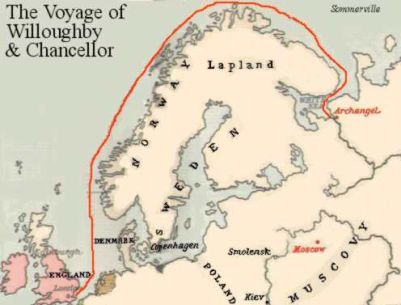 New trade routes for English cloth were opened in Africa - specifically in Morocco. This provided sugar and saltpeter, and Guinea, a source of gold. | |
| Culture under Mary I: Mary was a popular heroine and patron of the arts. She let English folk return to the religion they loved and she encouraged composers to get back to their great flamboyant tradition. With the composer Thomas Tallis, the pre-eminent composer of the period who had a long life, almost none of his music can be dated with certainty to within the five years of Mary's reign. The other is that Tallis's single work undoubtedly written for Mary, his splendorous Puer Natus Est Mass, suggests not so much a reawakened English medievalism as a grand swerve into the continental Renaissance. William Roper's biography of Sir Thomas More was written during the reign of Queen Mary; nearly twenty years after More's death. The actual work was not printed until 1626 when it became a primary source for More's earliest biographers because of Roper's intimate knowledge of his father-in-law. source:http://www.nytimes.com (Music review) Names like Thomas Tallis and John Sheppard are well known for being under Mary's wing. Mary and Jane Grey: 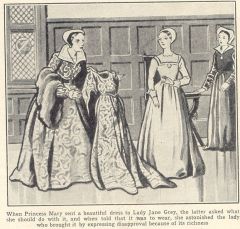 They were cousins and despite their religious differences (like Mary and Queen Catherine Parr) they were very respectful to each other. Mary often gave rich dresses to Jane (a common exchange between noblewomen and royals), who denied them not to be disrespectful, but because it was against her faith. When the queen's council tried to advise the queen to execute Lady Jane, she refused saying that Jane was much more a pawn and a victim. Unfortunately, after Wyatt's rebellion, Mary was urged to execute her cousin. Despite her personal feelings, the queen allowed her cousin's execution. Jane and her father were executed. To this day, Jane Grey is remembered as a tragic figure whose parents ruined her short life. Completely stunned with the rejection of her beloved husband, Mary said that she wanted to no longer see men and 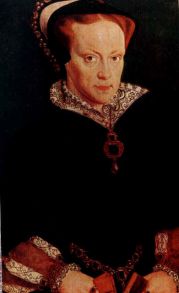 sank into depression. She wrote letters stained with tears to Philip and after receiving no answers, she blamed the "incompetence" of the messengers as if the messages had not reach their destination. She spent hours and hours on her knees praying or wandering around the castle as if she was a ghost. A fever, similar to malaria, struck England in the summer of 1558. The queen was hit by it in September. The queen, also the victim of "excess bile", hydrops ovarian, and possibly syphilis, became so weak that she suffered long periods of unconsciousness and once awakened from one of them saying she had dreamed that children were playing and singing around her. This may be where the "Bloody Mary" game came from. On November 17, she heard morning mass and by six o'clock she was dead. Pole, also struck by the same plague, died just hours after the queen. | Religious policy: Although Mary's religious policies started in a tolerant way towards Protestants, soon after the "Wyatt Rebellion", all of that changed. Mary was urged by her advisers to leave the "policy of leniency." Lady Jane Grey, her husband, and father, and eventually Thomas Wyatt, the Younger, were executed. Her half-sister, Elizabeth, was arrested as a suspect and taken to The Tower. All the heresy laws were reactivated and whoever denied the Catholic faith was sent to death. The Archbishops Cranmer, Latimer, Hooper and Ridley were all executed. The four had been mentors of the Reformation in England in the reign of Henry VIII and then the reign of Edward VI. Cranmer had been especially devoted to Henry's last wife, Queen Catherine Parr. Parr had taken a large role in the promotion of the reformed Church of England. As with Parr's mission -- leading this whole religious persecution was none other then the archbishop Stephen Gardiner. In November 1555, Mary lost a major ally: Gardiner. Archbishop Bonner, also an enemy of Queen Catherine Parr, assumed the persecutions and killings. Bonner was even more ruthless than Gardiner sending nearly 400 people to their deaths. Cardinal Pole, who has been portrayed as a persecutor in certain depictions of Mary's reign -- in fact, had no direct participation in the persecution. He was by nature almost as sensitive as the Queen - as they used to say, they were "made of the same flesh." Pole convinced Bonner to not send twenty women to death. However, said the major heretics, they were "removed from life as members of the body that had rotten." Unlike Pole's view, Mary I preferred to say that "the punishment of heretics should be done without haste, should, meanwhile, to apply justice to those who, by intelligence, seeking to deceive simple souls." In short, it would end with the Protestant pastors and bishops, not the people who hear his sermons. But with the politics of intolerance that Bonner required people to follow, that would be impossible. Thus, the smell of burned human flesh became an unmistakable smell on the streets of London. Far fewer people were burnt proportionally than in the Continental European repression. However, the burnings were concentrated in time and unprecedented by English standards. The executions became increasingly unpopular and promoted the Protestant cause rather then the Catholic one. Mary is too vilified because of the terrible persecutions, but it must be remembered that she acted just like any other monarch would have. Examples include her brother Edward VI and Kett's Rebellion and her half-sister, Elizabeth, who would go on to execute/kill 750 people in just one instance!
|
|
Mary Regina | 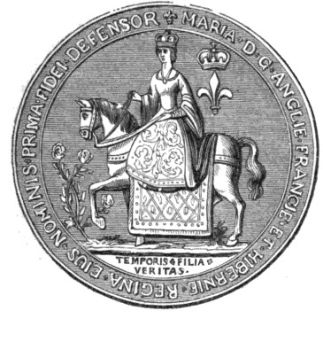 Mary as queen on a horse, note her titles and her motto in the picture. |
| Top 5 Things People Might Not Know About Mary Tudor in QUEENS AND KINGS By Anna Whitelock 1. Mary was engaged to be married, aged 2 and a half years old, to the French dauphin. In spite of her young age, Mary did, it seems, know something as to what was happening at the betrothal ceremony that took place at Greenwich palace in London. ‘Are you the Dauphin of France?’ She was reported to have said to the French ambassador: ‘If you are, I wish to kiss you.’ 2. With her mother, Catherine of Aragon’s guidance, Mary was highly educated and widely praised for her accomplishments. She was able to read a Latin letter by the age of nine and at twelve translated the prayer of St Thomas Aquinas from Latin into English. 3. Throughout her life, Mary loved to gamble. Her privy purse accounts reveal numerous amounts of money lost in this way. 4. She was the first ever woman to be crowned queen of England. Many people think it was Matilda, daughter of Henry I in the twelfth century, but she was never crowned and was given only the title ‘Lady of the English’. Up until Mary’s reign, English law was masculine referring only to kings. By a special Act of parliament in April 1554, Mary declared that women had all the power of men and queens could rule with all the force of law as their male counterparts. 5. Mary is buried beneath Elizabeth I in Westminster Abbey. Elizabeth was dug up from elsewhere in the abbey three years after her death and moved into her sister’s grave by king James I. Elizabeth’s presence in the grave is celebrated by a magnificent monument, the fact that Mary also lies there is acknowledged only by the Latin inscription ‘Partners both in throne and grave. Here rest we two sisters Mary and Elizabeth in the hope of one resurrection.’ About the author: Anna Whitelock received her PhD in History from Corpus Christi College, Cambridge, in 2004 with a thesis on the court of Mary 1. Her articles and book reviews on various aspects of Tudor history have appeared in publications including The Guardian, The Times Literary Supplement, and BBC History. She has taught at Cambridge University and is now a lecturer in Early Modern History at Royal Holloway College, University of London. In 2010, Whitelock, who was nominated by Antonia Fraser, received the Arts Club Emerging Writer Award. |
